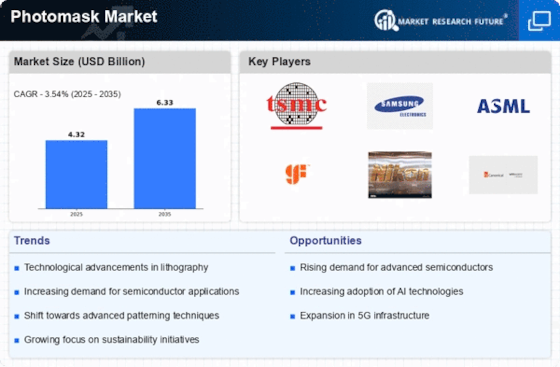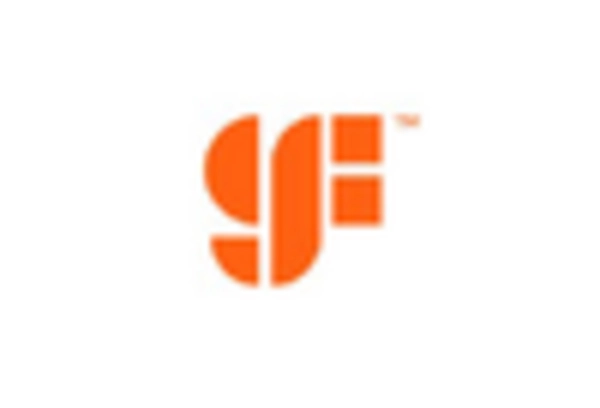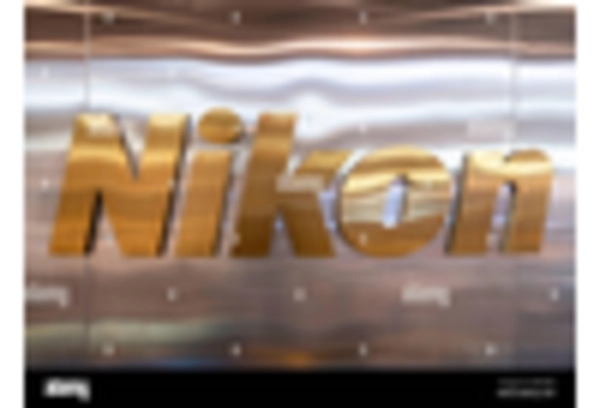Growth of Renewable Energy Technologies
The Photomask Market is also being propelled by the growth of renewable energy technologies, particularly in the production of solar cells and energy-efficient devices. As the world shifts towards sustainable energy solutions, the demand for high-performance photovoltaic cells is rising. Photomasks play a crucial role in the manufacturing of these solar cells, as they are essential for defining the intricate patterns required for efficient energy conversion. The renewable energy sector is anticipated to expand significantly, with projections indicating a market size of over 1 trillion dollars by 2030. This growth presents a substantial opportunity for the Photomask Market, as manufacturers seek to innovate and produce photomasks that meet the stringent requirements of renewable energy applications.
Regulatory Standards and Quality Assurance
The Photomask Market is increasingly shaped by stringent regulatory standards and quality assurance protocols that govern semiconductor manufacturing. As technology advances, regulatory bodies are implementing more rigorous guidelines to ensure product reliability and safety. Compliance with these standards necessitates the use of high-quality photomasks that meet specific performance criteria. This trend is particularly evident in sectors such as automotive and healthcare, where the reliability of semiconductor components is paramount. The emphasis on quality assurance is likely to drive demand for photomasks that adhere to these regulations, thereby fostering growth within the Photomask Market. Manufacturers that prioritize compliance and quality are expected to gain a competitive edge, further influencing market dynamics.
Increasing Demand for Semiconductor Devices
The Photomask Market is witnessing a robust increase in demand for semiconductor devices, which is a primary driver of market growth. As industries such as automotive, telecommunications, and consumer electronics continue to expand, the need for advanced semiconductor solutions becomes more pronounced. According to recent data, the semiconductor market is expected to reach a valuation exceeding 500 billion dollars by 2026, which directly correlates with the rising demand for photomasks used in the fabrication of these devices. This trend indicates a strong upward trajectory for the Photomask Market, as manufacturers strive to meet the growing requirements for high-performance and energy-efficient chips. The ongoing transition towards 5G technology and the Internet of Things (IoT) further amplifies this demand, suggesting a sustained growth pattern for photomask production.
Emergence of Advanced Packaging Technologies
The Photomask Market is significantly influenced by the emergence of advanced packaging technologies, which are reshaping the landscape of semiconductor manufacturing. Techniques such as 3D packaging and system-in-package (SiP) are gaining traction, allowing for greater integration of components and improved performance. These innovations necessitate the use of high-quality photomasks that can accommodate complex designs and multi-layered structures. As the market for advanced packaging is projected to grow at a CAGR of approximately 7% over the next few years, the demand for specialized photomasks tailored for these applications is likely to increase. This trend underscores the importance of adaptability within the Photomask Market, as manufacturers must evolve to meet the specific needs of advanced packaging solutions.
Technological Innovations in Photomask Design
The Photomask Market is experiencing a surge in technological innovations that enhance the design and production of photomasks. Advanced lithography techniques, such as extreme ultraviolet (EUV) lithography, are becoming increasingly prevalent, allowing for the creation of smaller and more intricate features on semiconductor devices. This shift is driven by the need for higher resolution and precision in chip manufacturing, which is essential for meeting the demands of modern electronics. As a result, the market for photomasks is projected to grow significantly, with estimates suggesting a compound annual growth rate (CAGR) of over 5% in the coming years. The integration of artificial intelligence and machine learning in photomask design processes further streamlines production, potentially reducing costs and lead times, thereby bolstering the Photomask Market.
















Leave a Comment